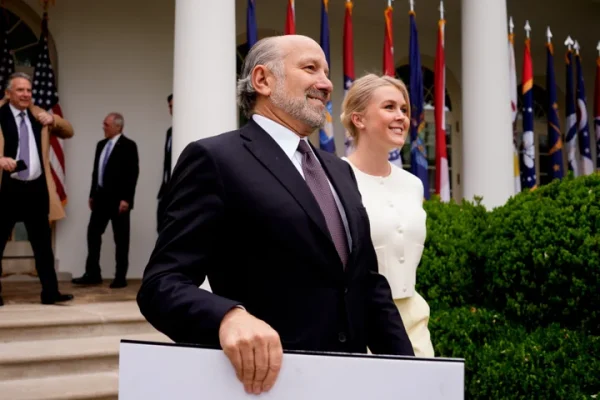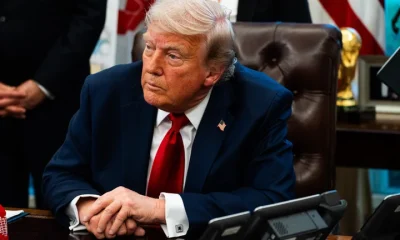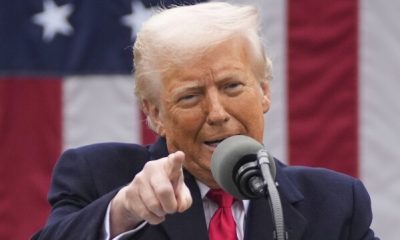POLITICS
Trump’s Rationales For His Tariffs Are Incoherent And Contradict Each Other

“Wouldn’t it be amazing to stop paying taxes to the Internal Revenue Service and have the External Revenue Service of Make America Great Again replace our taxes,” Commerce Secretary Howard Lutnick said.ANDREW HARNIK VIA GETTY IMAGES
Bring back manufacturing? Raise revenue? Negotiate with every country in the world? Trump can’t have his cake and eat it too.
President Donald Trump and his economic team justified last week’s sweeping “Liberation Day” tariffs with multiple conflicting explanations that, when considered together, make no sense at all.
The administration wants the public to believe three different things, all of which are in tension. First, Trump’s tariffs are designed to launch a renaissance for American manufacturing replaced by overseas imports, bringing back long lost working class jobs and reinvigorating the blue collar middle class. Second, that the tariffs are meant to raise massive amounts of revenue to replace the progressive income tax. And third, Trump’s advisers and various online sycophants also claim that the purpose is to use the tariffs as pressure on foreign nations to cut bilateral trade deals with the U.S.
These ideas may make varying levels of sense, in that they may do what those promoting them claim if executed strategically (albeit with differing levels of pain for the average American). But put together they make zero sense. Each is in conflict with the other. It can either be one thing or the other thing, but not all three things or even two out of three.
But since “Liberation Day,” the administration has flailed from one rationale to another, often with the administration openly contradicting itself within the hour.
On Monday morning, the Financial Times carried an op-ed from White House trade adviser Peter Navarro, where he declared: “This is not a negotiation.”
Hours later, Trump boasted online that “Countries from all over the world are talking to us. Spoke to Japanese Prime Minister this morning. He is sending a top team to negotiate!”
Soon after, Treasury Secretary Scott Bessent reposted Trump’s comment online to note that he would lead tariff negotiations with Japan.
These mixed messages were really just the healthy product of differing opinions, Council of Economic Advisors Chair Stephen Miran said on Monday.
“There are conflicting narratives because everyone’s got an opinion. That’s fine. Disagreement is how you can avoid groupthink, and I think that’s very healthy,” Miran said, according to a post by The Washington Post’s Jeff Stein.
Restore American Manufacturing
The main line from the Trump administration is that these tariffs are designed to restore America’s place as a manufacturing hub by bringing back the factory jobs that have been leaving the country since the 1960s.
“If you want your tariff rate to be zero, then you build your product right here in America,” Trump said when announcing his blanket tariffs on April 2.
The U.S. would now “charge countries” for “taking our jobs, taking our wealth, taking a lot of things that they have been taking over the years,” he added. (Tariffs are paid by the companies purchasing the imports, not their originating countries.)
This is what Trump ran on in 2024 when he called tariffs the “most beautiful word in the dictionary.”
“We’re going to bring the companies back,” Trump said in an interview with Bloomberg in October 2024.
“I think tariffs are a means to an end, and that end is bringing the manufacturing base back to the U.S.,” Bessent said on Fox Business in February.
This is, quite plainly, the point of tariffs. A country imposes a levy on imports as protection for the domestic market. This disincentives imports while incentivizing domestic production, especially if paired with an industrial policy that subsidizes or promotes domestic industry.
That is what the Biden administration did with its combination of tariffs and industrial policy enacted through the Inflation Reduction Act and the CHIPS & Science Act. Those two laws provided subsidies to build domestic production of microchips, electric vehicles, batteries and various other products for the clean energy sector. To protect these infant industries, Biden imposed tariffs, largely on goods from China where the industry is more developed. The most stringent of these was a 100% tariff on Chinese electric vehicles.
That was a targeted and strategic pairing of tariff policy and industrial policy aimed at reshoring jobs and building entirely new manufacturing industries. This is not what Trump’s “Liberation Day” tariffs look like.
Rather than strategically designed tariffs on countries with known unfair trade practices or targeting China’s unbalanced export economy, Trump’s tariffs hit almost every country in the world, including those that export products to the U.S. that cannot be manufactured or acquired here. No one can grow bananas in the United States nor do we have vast diamond mines.
At the same time, Trump is doing nothing to promote domestic industries or protect American workers. He is trying to unilaterally gut or not implement the Inflation Reduction Act’s subsidies meant to build domestic manufacturing capacity in the clean energy sector, and he’s called for Congress to repeal the CHIPS & Science Act. He is also actively working to undermine workers through National Labor Relations Board rulemakings and other anti-union and worker practices.
Still, there’s a reason this is the main rationale the administration promotes: It makes sense to the public and has public support. But it makes no sense when you look at the other explanations.
Raise Revenue To Replace The Income Tax
One of those other rationales is that tariffs will raise so much revenue that the U.S. will be able to eliminate the income tax.
“Wouldn’t it be amazing to stop paying taxes to the Internal Revenue Service and have the External Revenue Service of Make America Great Again replace our taxes,” Commerce Secretary Howard Lutnick said in March.
The thinking, if you can call it that, is that tariff revenue will be so high that the government can eliminate most income taxes.
“You’re going to see billions of dollars, even trillions of dollars coming into our country very soon in the form of tariffs,” Trump said in March.
This, in and of itself, doesn’t add up. The IRS raised $2.96 trillion in from individual and corporate income taxes in 2024 while the total cost of imports of foreign goods was $3.3 trillion. A 100% tariff on all imported goods might make up the entirety of individual and corporate income tax revenue, but, realistically, it would simply mean that those imports would just not come into the U.S. at all: Few people are willing to keep paying for something that has suddenly doubled in price.
Which gets at the conflict between the revenue raising rationale and the bring back manufacturing rationale.
If you want to raise lots of revenue then you would not want to see domestic manufacturing replace those imports: The imports must flow for the revenue to keep coming in, and you don’t want a cheaper alternative that avoids the tax.
And if you want to bring back manufacturing, you want a cheaper domestic product that is an appealing alternative, allowing companies and consumers to avoid the pricier imports entirely.
The administration is also fond of arguing that the U.S. used to do both ― impose tariffs for revenue and use them to build up domestic industries. But when Alexander Hamilton proposed this combo, as administration officials like to cite, the country was relatively poor and underdeveloped. Developed economies don’t rely solely on tariff revenue because they have the state capacity and knowledge base to implement a progressive income tax.
Negotiate Better Deals
Or maybe this whole thing isn’t about rebuilding domestic manufacturing capacity or raising revenue, but instead to force countries to make deals to get Trump to waive the tariffs.
“The tariffs give us great power to negotiate,” Trump said after imposing his “Liberation Day” tariffs. “They always have.”
“If you take it to zero, we’ll take it to zero,” Bessent said in February.
Deals, deals, deals. That’s what Trump is known for, so this rationale seems like common sense. But if you make deals with every country in the world to remove tariffs, you also undermine the other two rationales: less protection to rebuild domestic manufacturing capacity and less revenue from tariffs.
And there is a larger (theoretical) plan here, which Trump and his advisers do not talk about much publicly: to lower the value of the U.S. dollar.
That plan, known as the Mar-a-Lago Accord, is to smash the global economic system with massive tariffs in order to force countries to negotiate currency deals that lower the value of the dollar, which would help restore American manufacturing by making domestic products cheaper to export. Countries would then want to buy up American goods, like military equipment, cars and so on. This is all outlined in a paper by Miran.
But this plan doesn’t fully account for the alienation that Trump is creating from these would-be markets for U.S. goods. The tariffs combined with the U.S.’ foreign policy pivot to Russia have succeeded in getting the Europeans to actually invest in their economies and militaries, as evidenced by Germany’s recent constitutional change. But these countries are not looking for American goods. They are rather spurning the U.S. because of Trump’s belligerence.
Miran dismissed public speculation that Trump is pursuing his plan during a speech at the Hudson Institute on Monday.
“It’s not important,” Miran said about his paper outlining the plan to devalue the dollar. “It does not reflect administration policy.”
The end result of all of this is a muddled mess. The public has been fed at least three conflicting policy rationales while Trump insiders appear to pursue a broader, less-publicized plan to crater the dollar’s value by alienating the rest of the world.
Of course, Trump has harped on the importance of tariffs and protectionist policies as far back as the late-1980s. This is one of the few policies that he has a strong attachment to. There’s also the possibility these tariffs come not from a fully realized policy plan, but his own personal impulses. Impulses are rarely coherent.
If we’re to take these varying rationales literally, all signs point to impulse rather than serious policy. But that’s going to have serious long-term consequences for the entire world.



















